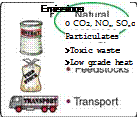The idea of a life cycle has its roots in the biological sciences. Living organisms are born; they develop, mature, grow old, and, ultimately, die. The progression is inherent in the organism—all follow the same path—but the way the organism develops on the way and its behavior and influence depend on its interaction with its environment—here, the natural environment. Life-cycle studies explore and track the interaction of organisms with their environment.
The life-cycle idea has since been adapted and applied in other fields: in the social sciences (the interaction of individuals with their social environment), in the management of technology (the study of innovation in the business environment), and in product design (the interaction of products with the natural, social, and business environments). Concern about resource depletion (the Club of Rome Report, already described), the oil crisis of the early 1970s, followed by the first evidence of carbon-induced global warming, focused attention on the last of these: the life cycle of manufactured products and their interaction, above all, with the natural environment. Products are made of materials; materials are their flesh and bones, so to speak, and these are central to the interaction. The study of product and associated materials life cycles involves assessing the environmental impacts associated with the full life of products, from the extraction of raw materials to their return to the ecosphere as waste—from birth to death, or (if you prefer) from cradle to grave. That means tracking materials through life. So let us explore that idea.
Figure 3.1 is a sketch of the material’s life cycle. Ore, feedstock, and energy, drawn from the planet’s natural resources on the left, are processed to give materials. These are manufactured into products that are distributed,
 |
 |
 |
||
The material life cycle 41
![]() The material life cycle. Ore and feedstock are mined and processed to yield a material. This material is manufactured into a product that is used, and at the end of its life, it is discarded, recycled, or, less commonly, refurbished and reused. Energy and materials are consumed in each phase, generating waste heat and solid, liquid, and gaseous emissions.
The material life cycle. Ore and feedstock are mined and processed to yield a material. This material is manufactured into a product that is used, and at the end of its life, it is discarded, recycled, or, less commonly, refurbished and reused. Energy and materials are consumed in each phase, generating waste heat and solid, liquid, and gaseous emissions.
sold, and used. Products have a useful life, at the end of which they are discarded, a fraction of the materials they contain perhaps entering a recycling loop, the rest committed to incineration or landfill.
Energy and materials are consumed at each point in this cycle, depleting natural resources. Consumption brings an associated penalty of carbon dioxide (CO2), oxides of sulfur (SOx), and of nitrogen (NOx), and other emissions in the form of low-grade heat and gaseous, liquid, and solid waste. In low concentrations, most of these emissions are harmless, but as their concentrations build, they become damaging. The problem, simply put, is that the sum of these unwanted by-products now often exceeds the capacity of the environment to absorb them. For some the damage is local and the creator of the emissions accepts the responsibility and cost of containing and remediating it (the environmental cost is said to be internalized). For others the damage is global and the creator of the emissions is not held directly responsible, so the environmental cost becomes a burden on society as a whole (it is externalized). The study of resource consumption, emissions, and their impacts is called life-cycle assessment (LCA).



